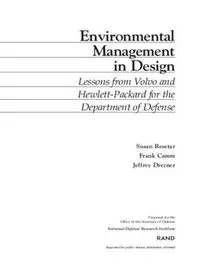
Environmental Management in Design - RAND Corporation PDF
Preview Environmental Management in Design - RAND Corporation
Environmental Management in Design Lessons from Volvo and Hewlett-Packard for the Department of Defense Susan Resetar Frank Camm Jeffrey Drezner Prepared for the Office of the Secretary of Defense National Defense Research Institute R Approved for public release; distribution unlimited The research described in this report was sponsored by the Office of the Secretary of Defense (OSD). The research was conducted in RAND’s National Defense Research Institute, a federally funded research and development center supported by the OSD, the Joint Staff, the unified commands, and the defense agencies, Contract DASW01-95-C-0059. Library of Congress Cataloging-in-Publication Data Resetar, Susan A. , 1961– . Environmental management in design : designs from Volvo and Hewlett- Packard for the Department of Defense / Susan Resetar, Frank Camm, Jeffrey Drezner. p. cm. “Prepared for the Office of the Secretary of Defense by RAND’s National Defense Research Institute.” “MR-1009-OSD.” Includes bibliographical references. ISBN 0-8330-2660-7 1. United States—Armed Forces—Weapons systems—Design and construction—Environmental aspects. 2. United States. Dept. of Defense—Procurement—Environmental aspects. 3. Defense contracts— United States—Environmental aspects. 4. Environmental management— Case studies. 5. Volvo, Aktienbolaget—Management—Environmental aspects. I. Camm, Frank A., 1949- . II. Drezner, Jeffrey A. III. RAND Corporation. IV. United States. Dept. of Defense. Office of the Secretary of Defense. V. National Defense Research Institute (U.S.). VI. Title. UF503.R47 1998 355' .07—dc21 98-43376 CIP RAND is a nonprofit institution that helps improve policy and decisionmaking through research and analysis. RAND’s publications do not necessarily reflect the opinions or policies of its research sponsors. © Copyright 1998 RAND All rights reserved. No part of this book may be reproduced in any form by any electronic or mechanical means (including photocopying, recording, or information storage and retrieval) without permission in writing from RAND. Published 1998 by RAND 1700 Main Street, P.O. Box 2138, Santa Monica, CA 90407-2138 1333 H St., N.W., Washington, D.C. 20005-4707 RAND URL: http://www.rand.org/ To order RAND documents or to obtain additional information, contact Distribution Services: Telephone: (310) 451-7002; Fax: (310) 451-6915; Internet: PREFACE Weapon systems are major drivers of the Department of Defense’s environmentally related activities. Consideration of these effects during early design offers a potentially significant payoff to military capability and overall environmental management activities. This report integrates information from case studies of Volvo and Hewlett-Packard with academic, policy, and trade literature to draw out lessons learned on best-in-class management processes that incorporate environmental concerns into new product design. It is intended for use by the Department of Defense to improve its envi- ronmental management practices during weapon system acqui- sition. This activity is part of a larger study that examined four areas of importance to DoD: designing weapon systems to have improved military capability and cost-effective environmental performance; managing the industrial processes in central logistics activities; bal- ancing environmental, military, and cost considerations in managing an installation; and managing remediation projects. Lessons from private industry leaders in these areas were examined for the Department of Defense. This report may be of interest to defense acquisition managers, weapon system designers, as well as to product managers, design engineers, and environmental policymakers in both the public and private sectors. The Office of the Deputy Under Secretary of Defense for Environmental Security sponsored this research. It was performed in the Acquisition and Technology Policy Center of RAND’s National iii iv Environmental Management in Design Defense Research Institute, a federally funded research and devel- opment center sponsored by the Office of the Secretary of Defense, the Joint Staff, the unified commands, and the defense agencies. CONTENTS Preface .......................................... iii Figures .......................................... vii Tables........................................... ix Summary ........................................ xi Acknowledgments.................................. xxiii Abbreviations ..................................... xxv Chapter One INTRODUCTION ............................... 1 Background ................................... 1 Analytic Approach ............................... 2 Report Roadmap ................................ 5 Chapter Two ENVIRONMENTAL ISSUES IN WEAPON SYSTEMS ACQUISITION.................................. 7 Design Implementation Must Consider Weapon Systems Diversity and Acquisition Reform Objectives ........ 9 Chapter Three WHAT IS DESIGN-FOR-ENVIRONMENT? .............. 13 Why Design? ................................... 13 Definition of Design-for-Environment ................ 16 Design-for-Environment Implementation.............. 18 Elements of Implementation...................... 19 v vi Environmental Management in Design Chapter Four NO SILVER BULLETS: ELEMENTS OF A COMPREHENSIVE PROCESS ....................... 21 Overarching Themes ............................. 21 Design-for-Environment Relies on the Individual Decisionmaker ............................. 21 Design-for-Environment Should Fit Within Existing Processes.................................. 22 The Design-for-Environment Processes Will Reflect Corporate Culture ........................... 23 Introducing Design-for-Environment Is Much Like a Typical Change Process ....................... 23 Vision and Strategy Focus Attention and Aid Decisionmaking............................. 24 Organizational Aspects Are the Most Critical to Design-for- Environment Implementation................... 28 Management Metrics and Goals ..................... 33 Metrics Reflect Corporate Strategy, Regulatory Issues, and Market Values ........................... 33 Goals Are Determined by the Responsible Parties ....... 35 Progress Toward Goals Is Tracked .................. 38 Suppliers Are Part of the Value Chain ................. 41 Training and Analytic Tools ........................ 44 Training .................................... 45 Analytic Tools ................................ 47 Engineering and Design Tools..................... 48 Accounting Techniques ......................... 53 Systems Engineering and Program Planning........... 53 Tool Development and Deployment ................ 53 Chapter Five CONCLUSIONS AND RECOMMENDATIONS........... 57 Appendix A. VOLVO CASE STUDY: DRIVING TOWARD GREEN ..... 63 B. HEWLETT-PACKARD CASE STUDY: PRODUCT STEWARDSHIP: GREEN COMPUTES ................. 121 Bibliography ...................................... 143 FIGURES A.1 Volvo Environmental Organizational Structure ..... 75 A.2 Building Blocks of an Environmental Program ...... 87 A.3 Template for Advanced Engineering Planning ...... 93 B.1 Fountainhead Database Structure ............... 133 vii TABLES 1.1 Illustrative Weapon System Characteristics ........ 11 4.1 Sample Management Metrics .................. 34 A.1 Volvo Car Corporation Goal Set ................. 91 A.2 Goals of the Volvo “Environment 95” Program ...... 118 B.1 HP Corporate Product Stewardship Time Lines ..... 123 B.2 HP Corporate Stewardship Metrics .............. 136 ix
